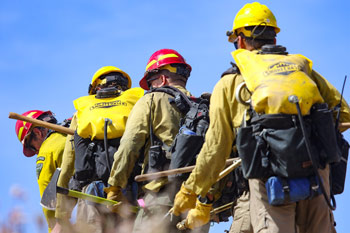Click Here for California Fires
July 16, 2024 - Currently, 59 large active wildfires are currently being managed nationwide, and have burned 933,583 acres. Fire managers are using full suppression  strategies on 39 of these wildfires. More than 18,760 wildland firefighters and support personnel, 21 complex incident management teams, and 5 type 1 incident management teams are assigned to incidents across the nation.
strategies on 39 of these wildfires. More than 18,760 wildland firefighters and support personnel, 21 complex incident management teams, and 5 type 1 incident management teams are assigned to incidents across the nation.
Evacuation orders are in effect for residents near the Lone Rock, Larch Creek, Falls, Pioneer, Graff Point, Bench Lake, Miller Creek, Horse Gulch, Shelly and Black fires. If you live in an area that has been evacuated, please follow the instructions from local authorities. They will provide the latest recommendations based on the threat to your community and appropriate safety measures.
Since January 1, 24,766 wildfire have burned 3,088,589 acres in the United States. More than 24,160 of these wildfires were started by people, compared to about 1,500 that were ignited by lightning. States with the most human-caused wildfires include California, Georgia, Florida, Texas and Missouri. With temperatures hitting record highs in many areas, it's imperative we all do our part to recreate responsibly and prevent wildfires.
The Great Basin Coordination Center's predictive services staff have issued three fuels and fire behavior advisories for Nevada, Southern Idaho and Utah and Arizona Strip. There is also a fuels and fire behavior advisory in effect for California. Residents, travelers, or workers on their way to any of these states should be advised and familiarize themselves with the elevated risks.
The national predictive services staff at the National Interagency Coordination Center released the National Significant Wildland Fire Potential Outlook for July through October. For additional information about the current outlook visit the Outlook page on the NICC site.
When it comes to protecting homes and communities from wildfires, firefighters can not do it alone. As more of us live in the urban interface where homes and communities meet the wildlands, wildfire prevention and protection become everyone’s responsibility. Simple Firewise steps can help you and your neighbors minimize your risk from wildfire and maximize your safety. Reduce your risks and help our firefighters by becoming fire adaptive and Firewise. Learn about Fire Adaptive Communities here: http://fireadapted.org/
A wave off the California coast will move into the Oregon Cascades tonight triggering isolated mixed wet and dry thunderstorms over far northern California and southwest Oregon that will continue overnight from central Oregon westward to the coast. Breezy and dry southwesterly winds are also forecast for portions of northern California as well. Farther east, isolated mixed wet and dry thunderstorms will develop over much of the Great Basin, with wetter thunderstorms over the eastern Great Basin into Wyoming, the West Slope, and Southwest. Well above normal temperatures are forecast for the Northwest through central/western Montana, with afternoon relative humidity below 20% east of the Cascade Crest. Cooler temperatures are forecast for eastern Montana and the northern High Plains south to the Colorado Front Range behind a cold front. Above normal temperatures are forecast from the southern Plains into the Southeast and Mid-Atlantic, with records possible in the Mid-Atlantic. Breezy westerly downslope winds are also possible in portions of central Virginia and Maryland. Scattered showers and thunderstorms will develop ahead of a cold front from the Front Range into the eastern Great Lakes, Ohio Valley, and Northeast. Cool and wet conditions continue for Alaska, while dry trade winds in Hawai’i decrease to light to moderate during the day.
| Number of new large fires or emergency response * New fires are identified with an asterisk |
4 | States currently reporting large fires: |
| Number of active large fires Total does not include individual fires within complexes. |
59 | |
| Acres from active fires | 732,099 | |
| Fires contained | 4 |
Year-to-date statistics
| 2024 (1/1/24-7/16/24) | Fires: 24,766 | Acres: 3,088,589 |
| 2023 (1/1/23-7/16/23) | Fires: 27,071 | Acres: 770,291 |
| 2022 (1/1/22-7/16/22) | Fires: 17,620 | Acres: 5,238,977 |
| 2021 (1/1/21-7/16/21) | Fires: 34,596 | Acres: 2,364,643 |
| 2020 (1/1/20-7/16/20) | Fires: 28,423 | Acres: 1,778,583 |
| 2019 (1/1/19-7/16/19) | Fires: 23,054 | Acres: 2,191,960 |
| 2018 (1/1/18-7/16/18) | Fires: 34,181 | Acres: 3,409,055 |
| 2017 (1/1/17-7/16/17) | Fires: 34,586 | Acres: 4,371,963 |
| 2016 (1/1/16-7/16/16) | Fires: 29,613 | Acres: 2,611,378 |
| 2015 (1/1/15-7/16/15) | Fires: 32,400 | Acres: 5,458,425 |
| 2014 (1/1/14-7/16/14) | Fires: 29,812 | Acres: 1,118,949 |
10-year average Year-to-Date
| 2014-2023 | Fires: 30,804 | Acres: 2,878,774 |
Source: NIFC








